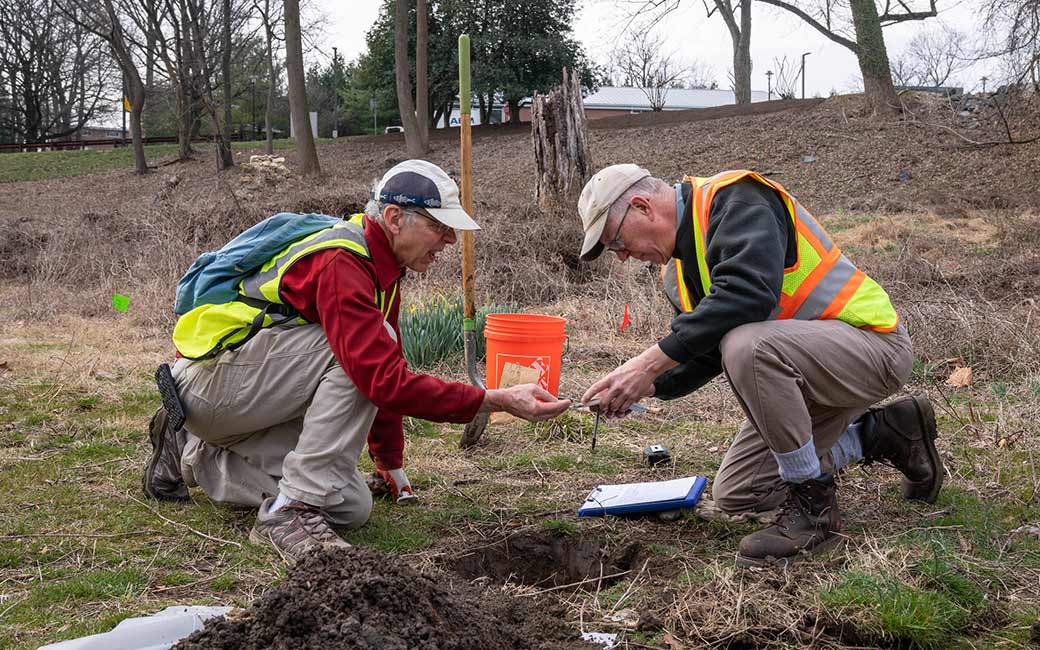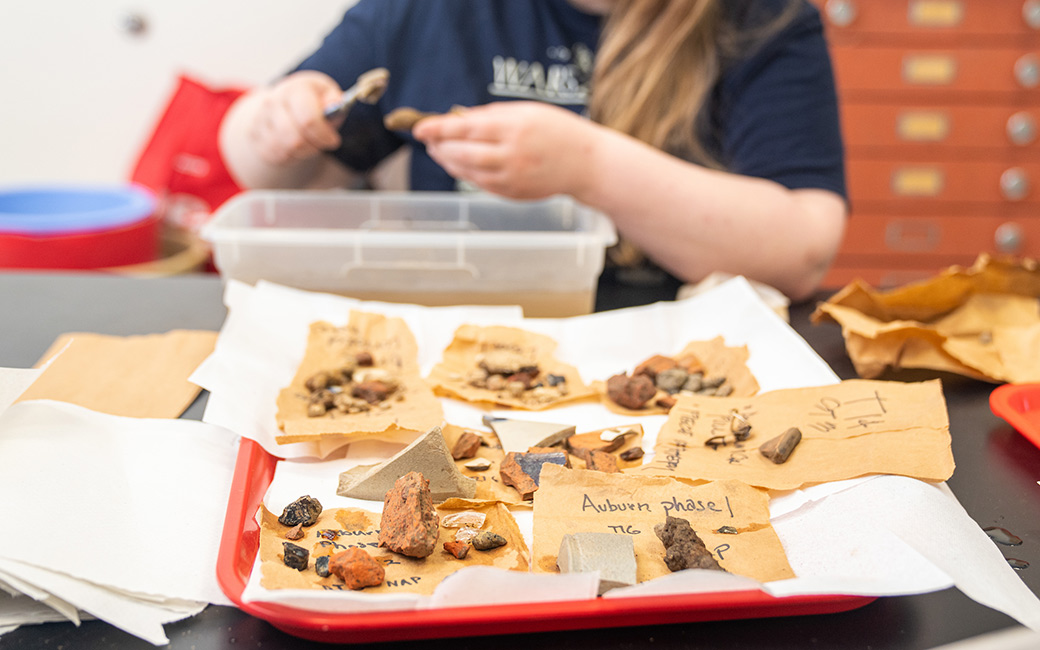
TU community works together to solve the mystery of campus ruins
Cleanup creates opportunities for students, interdisciplinary collaboration
By Rebecca Kirkman on May 30, 2023
One day in winter 2021, longtime Rodgers Forge resident Albert Ward’s near-daily walks through Towson University turned from ordinary to extraordinary when he noticed stones sticking out of the vines in an area just west of Osler Drive.
Ward introduced himself to Landscape Services volunteer Greg Hoer, who was cleaning brush from the area and learned about the recent discovery of previously unknown ruins on the land adjacent to Auburn House and the interdisciplinary effort to solve the mystery behind them.
His curiosity was piqued, and soon Ward was part of a growing group of passionate Landscape Services staff and volunteers digging into local archives and talking with longtime area residents.
“It’s been great to see it take shape,” he says. “People in the community have noticed and gotten involved.”
The oldest building on campus, Auburn House dates to the 1700s and is on the National Register of Historic Places. Based on documents available in the university archives and in public records, the ruins are believed to be the remnants of a pump house used to provide water to the main home as well as a larger foundation in what was once a formal Italian sunken garden.
“It brings the community together,” says Donna Anderson, manager of landscape services, of the mystery, which has become a pet project among seven Landscape Services staff members and two volunteers. The area was discovered by then-student worker John Hightower and stormwater management staff member Deborah Rowan while clearing invasive plants and fallen trees in the area.
Since the initial discovery, Anderson has convened a growing team of experts across the university and the neighborhood. “We wanted to learn more about how to proceed,” she says, adding that Landscape Services is “all about education and supporting the mission of the university.” Those experts include Katherine Sterner, assistant professor of anthropology, who gave a presentation to the Landscape Services team about historic preservation and facilitated a field survey of the area over two days this spring.
“This is our first on-campus fieldwork to see what else might be out there,” Sterner says. “We know there's a stone path that leads to the one larger foundation, but we’re not sure where it goes. This process will help us locate where the path goes and if there are any other cultural remains out there.”
Led by Caitlyn Adams ’22, Sterner’s former student and an archeology assistant for Montgomery County Parks, and assisted by members of the TU Archeology Club, the group included volunteers, students, faculty and staff.
They dug holes at regular intervals and screened the soil in search of artifacts and historic debris—a method called shovel testing. When they found debris—such as pieces of building materials, including brick and stone, glass bottles and ceramic pottery—they bagged them and recorded the depth, soil color and gravel content before filling the hole and moving on to the next.
Campus Heritage Resource Management
Discovery of the ruins inspired an interdisciplinary group of campus partners to embark on the process of developing a campus archeology and historic resource management program at TU. The group includes staff and faculty in Facilities Management; the Department of Sociology, Anthropology & Criminal Justice; the Department of History and Special Collections & University Archives at Cook Library.
For student researchers, shovel testing and identifying material is an opportunity to put what they learn in the classroom into practice.
“In class, professor Sterner explained what we’re supposed to look for, and it’s cool being out in the field actually doing it,” says Marquis Newhouse, a junior in ANTH 212: Paleoanthropology and Archeology.
Back in the lab, the students cleaned and cataloged the artifacts found during shovel testing.
“Most artifacts were found in the first 40 centimeters of soil below the ground surface, coming from shovel tests in the southern corner of the site,” Sterner says. “This suggests that there may be additional subsurface deposits in that direction, beyond the two structures visible above ground.” All diagnostic artifacts date between 1830 and 1920, the period when the house was occupied by the Turnbull family.
Future work at the site will consist of additional shovel testing to the north and south of the previously tested areas to see if there are earlier deposits from before the Turnbull era as well as to identify other possible Turnbull features.
Over the summer, Sterner plans to do additional artifact analysis and archival research with the intent of applying for internal and external grant funding to continue the project in the 2023–24 academic year.


